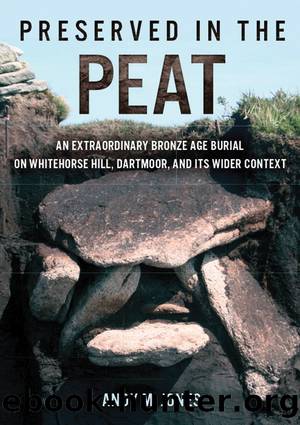Preserved in the Peat by Andy M. Jones

Author:Andy M. Jones
Language: eng
Format: epub
Publisher: Casemate Publishers & Book Distributors, LLC
Published: 2017-05-15T00:00:00+00:00
Figure 18.4: Schematic diagram showing the construction elements of the textile and animal-skin object, section view. Annotation as for plan view, E = lower textile layer. (Drawing: S. Harris.)
Figure 18.5: The lower textile layer showing multiple rows of parallel, S-plied yarn running lengthways. (Photograph: Helen Williams, Wiltshire Conservation Centre.)
The analysis of threads from the textile component found both to be of vegetable fibre. With the hope of identifying the plant fibre species, the encrusted fibres were cleaned by gently macerating with hydrogen peroxide, distilled water and glacial acetic acid (Appendix B, below). Following cleaning, the VP-SEM examination carried out by Caroline R. Cartwright concluded that two fibres could be closely matched with nettle (Urtica dioica) (Appendix B).
Bronze Age textile manufacture: the wider context
Recent overviews of textile technology in the British Isles have concentrated on the Late Bronze Age and Iron Ages (DeRoche 2012; Wincott Heckett 2012). Hence, the main comprehensive reviews of Early to Middle Bronze Age textiles in Britain remain Henshall (1950) and Bender Jørgensenâs chapter on Great Britain and Ireland and the catalogue in her analysis of north European textiles (Bender Jørgensen 1992, 18â19, 197â198). These are supplemented by published and unpublished textile reports (Gabra-Sanders 1994; Crowfoot in Green and Rollo-Smith 1984, 311â312; Harris 2012; Hedges 1974; Jones et al. 2011, 89; Walton Rogers 2008).
Fibres: identification and evidence of processing
In Bronze Age Europe the most commonly identified textile fibres are linen from the flax plant (Linum usitatissimum) and wool. While it is relatively easy with microscopic examination to distinguish plant (also referred to as vegetable or cellulose) from animal fibre, species identification is more problematic. Although quoted in later literature, early species identifications should be treated cautiously, as for example the âfine fibre resembling flaxâ of textiles from Garton Slack, Yorkshire (Mortimer 1905, 234), which seems little more than speculation (Henshall 1950, 142). Although recent fibre identifications for Bronze Age Britain are scarce, both flax and nettle fibres have been identified, albeit sometimes tentatively. Fibres from a plain weave textile from Must Farm, Cambridgeshire, were identified as almost certainly flax, while those from a tapestry weave textile at the same site were identified as possibly flax (Walton Rogers 2008). Fibres on the back of a small, bronze pendant from a vessel containing a cremation at Harlyn Bay, Cornwall (2120â1880 cal BC, SUERC-15536) are identified as âmost likely linenâ but could also be from another species (Jones et al. 2011, 89).
The identification of nettle fibres is relatively rare on a European scale. A textile from the socket of a spearhead in a hoard found at Pyotdykes, Angus, Scotland (eighth century cal BC), was first identified by Ryder as flax (Henshall 1964, 198) but Hedges later suggested the fibres could be nettle (Hedges 1973, 61â69, 213â214, quoted in Gabra-Sanders 1994, 41). A Late Bronze Age textile (ninthâeighth century cal BC) from Denmark, discovered inside a bronze cauldron at Lusehøj, near Voldtofte in south Funen, was identified as nettle fibre (Mannering et al. 2012, 97). More recently, fibres from a plain
Download
This site does not store any files on its server. We only index and link to content provided by other sites. Please contact the content providers to delete copyright contents if any and email us, we'll remove relevant links or contents immediately.
| Automotive | Engineering |
| Transportation |
Whiskies Galore by Ian Buxton(41525)
Introduction to Aircraft Design (Cambridge Aerospace Series) by John P. Fielding(32885)
Small Unmanned Fixed-wing Aircraft Design by Andrew J. Keane Andras Sobester James P. Scanlan & András Sóbester & James P. Scanlan(32570)
Craft Beer for the Homebrewer by Michael Agnew(17930)
Turbulence by E. J. Noyes(7696)
The Complete Stick Figure Physics Tutorials by Allen Sarah(7135)
Kaplan MCAT General Chemistry Review by Kaplan(6592)
The Thirst by Nesbo Jo(6432)
Bad Blood by John Carreyrou(6271)
Modelling of Convective Heat and Mass Transfer in Rotating Flows by Igor V. Shevchuk(6219)
Learning SQL by Alan Beaulieu(6031)
Weapons of Math Destruction by Cathy O'Neil(5825)
Man-made Catastrophes and Risk Information Concealment by Dmitry Chernov & Didier Sornette(5644)
Digital Minimalism by Cal Newport;(5388)
Life 3.0: Being Human in the Age of Artificial Intelligence by Tegmark Max(5182)
iGen by Jean M. Twenge(5158)
Secrets of Antigravity Propulsion: Tesla, UFOs, and Classified Aerospace Technology by Ph.D. Paul A. Laviolette(4984)
Design of Trajectory Optimization Approach for Space Maneuver Vehicle Skip Entry Problems by Runqi Chai & Al Savvaris & Antonios Tsourdos & Senchun Chai(4837)
Electronic Devices & Circuits by Jacob Millman & Christos C. Halkias(4744)
